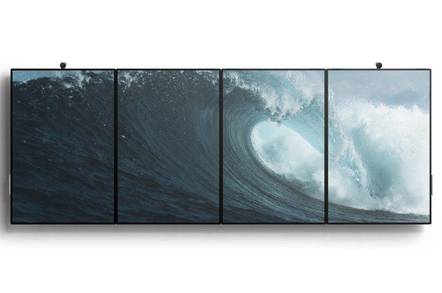Coming to a meeting room near you in 2019
In a video heavy on a dramatic orchestral music and hints of new Windows interfaces, but somewhat light on detail, Microsoft showed off the newest edition of the overpriced whiteboard business collaboration tool.
Youtube Video
The existing Windows 10-powered device began shipping in 2016 and the multitouch screens currently come in 55-inch and 84-inch flavours at $8,999 and $21,999 respectively. While not initially a runaway sales success, it has gained a foothold in the corporate space with Microsoft claiming 5,000 customers (including over half of the Fortune 100 companies.)
The Surface Hub is aimed fairly and squarely at customers who have bought into Microsoft’s collaboration platforms, and while a good proportion of the screens will have found themselves serving up interminable PowerPoint presentations, that really isn’t the point of the thing. Microsoft hopes users will leap from their seats and prod the screens with excited fingers.
The new incarnation, currently only a 50.5-inch display although with a welcome resolution bump to what Microsoft is calling “4K+”, ups the ante somewhat. Skinny bezels allow up to four of the things to be snapped together, giving a wide display showing multiple applications.
4K cameras and far-field mics mean that hiding in teleconferences will become even more of a challenge, while a wall mount that allows the 3:2 ratio screen to rotate between landscape and portrait makes for a great demo. How much real-world use such a feature would see is debatable.
Microsoft is, of course, not the only game in town. Google’s Jamboard, launched last year, for $4,999 (with a $600 annual support bill), offers similar functionality at a lower cost for those who have embraced Google’s platform. Similarly, Cisco will be very happy to trouser $10,000 for its humongous 70-inch collaboration screens, along with a $190 monthly bill for the privilege of using the it.
Some users may look to Microsoft’s other tools, such as the augmented-reality of HoloLens, as a way to boost collaboration in the workplace without having to bolt expensive displays to walls (although Redmond is rather proud of the trolleys and stands that will be available to purchase.)
With previews of the devices due to arrive later this year and general availability happening in 2019, it will be a while before actual hardware is in the hands of users. It is expected the Hub 2 will be pitched at around the same price as the current device.
Microsoft has had some success in the niche it has carved with the Hub, bringing innovation into a space normally occupied by whiteboards and dried-out marker pens, but businesses also need to keep in mind that improving collaboration and communication between teams often requires more than just a shiny new toy – even if it can spin on the wall. ®






